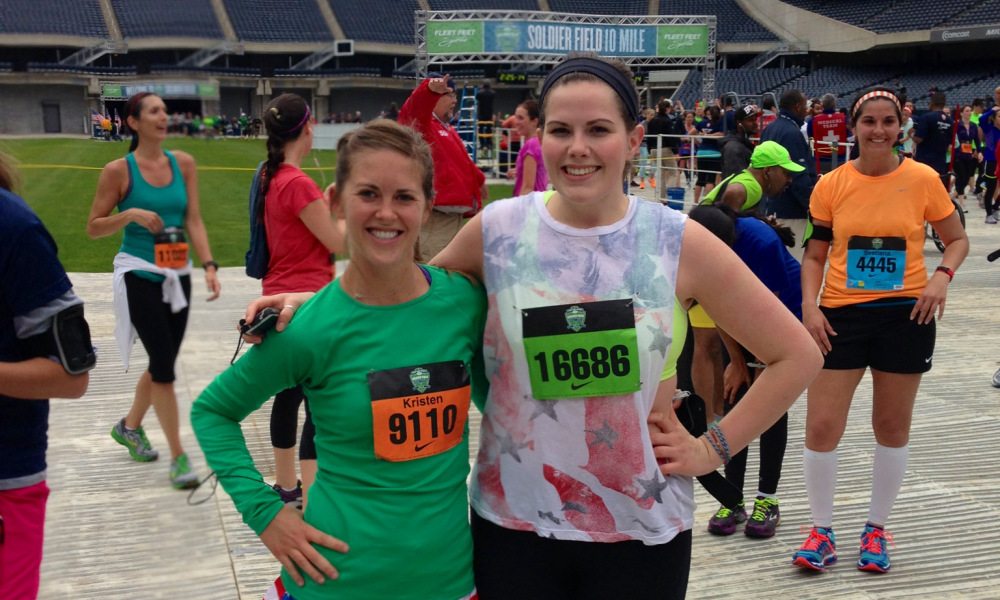Marathon Monday: Putting Your Best Foot Forward

I am pretty sure that it is internet law to link to the “OMG, shoes” video any time you write a blog post about shoes. However, I never really liked that video, and I’m much more of a Nelly girl myself, so here’s your alternative:
When I first started planning this harebrained marathon training adventure, one of the first questions I ran into constantly was “What shoes are you running in?” to which I charmingly answered, “Uh, the ones I have,” while gesturing towards my feet. As I began my nervous researching phase of marathon training (and picked up a pair of sweet new Nike Air Zoom Pegasus 31s in the process), I read more and more about the benefits of alternating your running shoes between runs. It’s something I think every runner should be aware of. Let me break it down for you:
More Mileage
There’s no hard and fast rule for how often you should retire your running shoes, but running experts place it anywhere from after 250 miles to 500 miles. You’ll know when it’s time to retire your shoes because your body will tell you in the form of consistent aches and pains- and if you need confirmation, take your beloved old pair to your local running store and try on a pair of brand new shoes in the same model. If you can tell the difference, it’s time to hang up the old laces. I definitely recommend tracking the miles you put on your shoes in your training log or with the Nike+ Running App.
This is a long-winded way of saying – by alternating your running shoes, you reduce the mileage on either shoes, and you’re able to keep them in your rotation for longer. Also, both pairs are sharing the burden of being exposed to the elements.
Reduced Injury Risk
According to The Marathon Solution, rotating running shoes reduces your injury risk. They note that “Going from a completely exhausted pair of running shoes (approximately 400+ miles) to a brand new pair can be too much of a radical change and places unnecessary stress on your lower extremities – often resulting in injury. Rotating multiple pairs of shoes prevents your legs from being accustomed to just one range of motion, even if you’re running in multiple pairs of the same model.”
Allows Shoes to Recompress/Dry Out
Your running shoes have compression in the soles (ethylene vinyl acetate, or thousands of tiny air bubbles, if you want to get technical), which work to absorb shock and give your foot the cushioning and stability it needs. After a long run beating your body weight into these soles, your shoes need a rest day to recompress and bounce back up. Rotating your running shoes, especially if you’re running every day, ensures that you’re giving your shoes ample recovery time.
Similarly, if you frequently run in the run or snow (hello, spring marathon training!), your shoes need time to dry out in between runs, or else you run the risk of gross things like athlete’s foot. Only you can prevent athlete’s foot.
If the Shoe Fits…
If you find a shoe you love and that makes you feel lighter than air when you’re running, don’t hesitate: buy two pairs. As the thousands of running shoe forum participants will attest (“WHY DID NIKE RETIRE THE AIR MAX 95?!”), shoe companies tweak their formula on an annual basis, and the model that works for your foot one year may not work the next. Scoop up your best-fitting shoes while you can. Better safe than sorry, injured, and suffering from athlete’s foot (that was a little dramatic, but you get the picture).
Full disclosure: I’m poor. The thought of buying two pairs of running shoes at the same time hurts my heart and my wallet just a little bit. If you can’t afford to buy two pairs of shoes at the same time, buy your second pair about halfway through your training. Or, alternatively, be savvy about semi-annual sales when planning your shoe purchases. But in the long run (so many good puns in this post!), if buying two pairs of shoes helps me decrease my risk of injury, I’ll do it in a heartbeat while mentally berating 2012 Kristen for not doing so before the Broken Heel Incident.
Also, before you even head to the checkout line with two shoeboxes under your arm, make sure that you’ve been properly set up with a pair of shoes that works for your running style and gait. The friendly experts over at Fleet Feet, the new Asics in Bucktown, or Nike are all willing to help you out and hook you up with new sneaks. Now, go forth and be a badass running Cinderella with your metaphorical glass slippers.
For all you veteran runners out there, how do you alternate your running shoes- every other run? Long runs versus short runs? Have you ever been injured from (literally) running one shoe into the ground? Let me know in the comments, I’ll take all the advice I can get!












